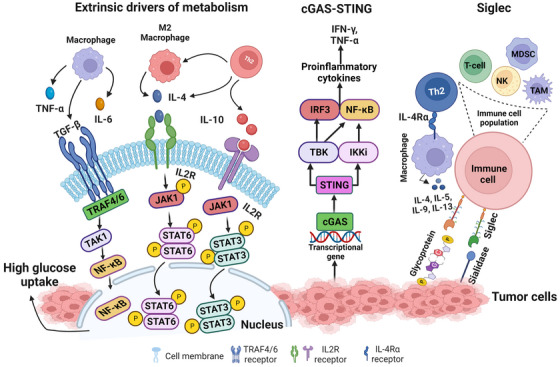FIGURE 1.

Hormones, metabolites and cytokines released by the microenvironment regulate gene expression to increase glucose uptake and glycolysis in the tumor cell. cGAS‐STING cellular signaling pathway is activated upon recognition of double‐stranded DNA in the cytosol. cGAS in turn activates the STING protein on the ER to initiate downstream signaling, primarily through TBK‐1 and IKK. STING activation typically leads to the activation of transcription factors, IRF3 and NF‐κB1, which is known to partially inhibit the activity of NF‐κB1. STING signaling results in the production of IFN‐I and TNF‐α proinflammatory cytokines. Siglec‐sialic (sialidase) axes signaling to represent siglecs on the surface of immune cells and binding with sialic on tumor cell leads to the deactivation of immune response by all the immune cell population as siglec express on most of the immune cell (e.g., T‐cell, TAM, MDSC, NK and neutrophils). Created with BioRender.com Abbreviations: cGAS: cyclic GMP–AMP synthase; STING: stimulator of interferon genes; ER: Endoplasmic Reticulum; TBK‐1: TANK‐binding kinase 1; IKK: nuclear factor‐κB (IκB) kinase; IRF3: Interferon regulatory factor 3; NF‐κB1: nuclear factor κB1; IFN‐I: Type I interferons; TNF‐α: Tumour necrosis factor α; TAM: Tumor‐Associated Macrophage; MDSC: Myeloid‐derived suppressor cell; NK: Natural Killer, TRAF: Tumor‐necrosis factor Receptor‐Associated Factor, TAK: TGF‐β‐activated kinase.
